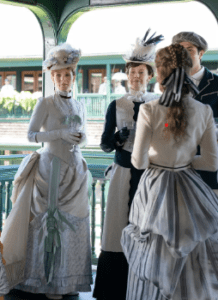 The tradition of not wearing white after Labor Day is a long-standing fashion rule with deep roots in American history. This custom, which emerged in the late 19th and early 20th centuries, was once a clear marker of social status and seasonal change. While the rule has evolved and relaxed over time, it still holds a place in fashion consciousness today, reflecting both our cultural history and modern style sensibilities.
The tradition of not wearing white after Labor Day is a long-standing fashion rule with deep roots in American history. This custom, which emerged in the late 19th and early 20th centuries, was once a clear marker of social status and seasonal change. While the rule has evolved and relaxed over time, it still holds a place in fashion consciousness today, reflecting both our cultural history and modern style sensibilities.
Origins of the Tradition
The origins of the “no white after Labor Day” rule can be traced back to the late 1800s and early 1900s, a period when America’s upper class began to establish more defined fashion norms. During the summer months, wealthy families would leave the hot, dusty cities for cooler, more relaxing destinations such as rural estates, seaside resorts, or mountain retreats. In these settings, light-colored clothing, particularly white, was not only a practical choice due to the heat but also a symbol of leisure and affluence. White garments, typically made of light, breathable fabrics like linen, became synonymous with summer vacations and the easy, carefree lifestyle associated with them.
As the summer season ended, so too did the period of wearing white. Labor Day, a national holiday in the United States, became the unofficial marker for the end of summer and the return to the structured routines of work and social life in the cities. With this transition, the upper class would pack away their white clothes in favor of darker, more formal attire suitable for the cooler months. This shift in wardrobe was more than just a practical decision; it was a way for the elite to distinguish themselves from those who did not have the means to change their wardrobes seasonally.
The Rule Becomes a Social Norm
By the early 20th century, the “no white after Labor Day” rule had become an established social norm. It was an unwritten fashion code that signified one’s awareness of societal expectations and one’s place within the social hierarchy. To wear white after Labor Day was seen as a breach of etiquette, a sign that one was either unaware of or indifferent to the rules of the elite.
This fashion rule also reflected the broader societal changes of the time. The Industrial Revolution and the subsequent rise of the middle class led to more people emulating the styles and behaviours of the upper class. The “no white after Labor Day” rule became a way to demonstrate one’s adherence to these newly established norms, a marker of sophistication and social awareness.
How the Tradition is Observed Today
The “no white after Labor Day” rule is far less rigid in contemporary fashion. Today, the rule is often outdated, with many fashion enthusiasts and designers rejecting the idea that the calendar should dictate one’s wardrobe. The rise of global fashion trends, the influence of warmer climates, and the increased casualization of dress codes have all contributed to the fading of this once-strict rule.
Fashion today is about self-expression and personal style rather than strict adherence to traditional norms. White clothing is now worn year-round, with designers and influencers embracing the colour for its versatility and timelessness. From winter whites to minimalist aesthetics, white has secured its place in modern wardrobes across all seasons.
However, for some, the tradition still carries a certain nostalgic charm. The transition from white summer dresses and light linens to darker, richer fabrics as autumn approaches can feel like a nod to the changing seasons, a way to mark the passage of time in a world where seasonal changes are less pronounced in our daily lives.
Conclusion
The “no white after Labor Day” rule is a fascinating piece of fashion history that reveals much about social structures, cultural norms, and the evolution of styles. While its strict enforcement has largely faded, the tradition remains a point of interest for fashion historians and a topic of conversation for style-conscious individuals. Whether you adhere to or break this rule, understanding its origins and how it has evolved allows us to appreciate the rich tapestry of fashion history and its ongoing influence on how we dress today.

